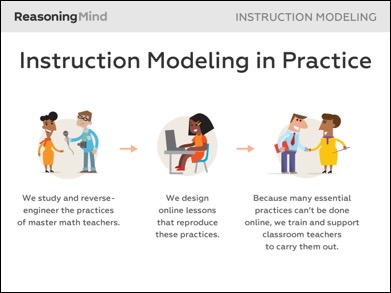Today, more and more campuses are experimenting with education technology (edtech) tools in an effort to improve engagement and instruction for their students. These technology tools can range from video lectures on particular topics like you’ll find from Khan Academy, to behavior management apps like ClassDojo, to full-fledged digital curricula. But approaches to edtech program design—and the resulting impact on student outcomes—can vary widely. So what’s the recipe for making an effective edtech program?
At Reasoning Mind—an education nonprofit that develops blended learning programs for PK-8 mathematics—we’ve pioneered a unique approach to edtech design we call “Instruction Modeling”. Instruction Modeling is, in essence, a process by which we meticulously study the experiences of students in world-class math classrooms, and then build digital learning programs that replicate those same learning experiences. The idea is inspired by a concept in artificial intelligence known as an expert system, which is a computer program designed to replicate the thought process of a human expert.

Using this approach, a standard lesson at Reasoning Mind would be created as follows. First, we’d find an experienced master math teacher. Then, our Knowledge Engineers (the staff responsible for reverse-engineering the teacher’s practices) would conduct extensive interviews with the teacher, usually for more than five hours. Out of these sessions would come over fifty pages of detailed notes on everything from the lesson outline and content, to what the students should be thinking, to the hand gestures the teacher would be making. Next, our team of software designers and curriculum experts would use these interview notes and lesson outlines to design an animated, interactive computer lesson that reproduces the very practices used by the master teacher. And finally, because many essential aspects of education simply can’t be done by a computer alone, we partner with schools using our digital programs to provide classroom teachers with training, implementation support, and professional development throughout the year. To see what this ends up looking like in practice, view this short YouTube video.
So why do we go through the trouble of producing programs in this manner? Our philosophy is that technology itself should not be the focal point of edtech—rather, technology should be used primarily as a mechanism to deliver tried-and-true educational best practices to more students across the world. If edtech providers focus only on slick tech features, or use their platforms to replicate unproven teaching practices, they’re unlikely to produce much of a positive impact on student learning.
For more on this approach, see a recent TEDx talk by our co-founder, George Khachatryan, below. And for an even more detailed analysis of Reasoning Mind’s program creation process, see this paper in the International Journal of Artificial Intelligence in Education.
The post Guest Post: Reasoning Mind’s Recipe for Creating Effective EdTech Programs appeared first on talkSTEM.